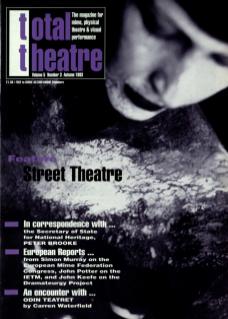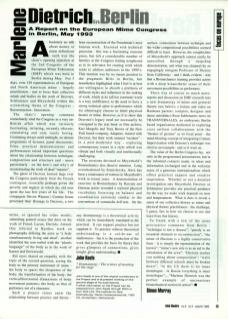Absolutely no talk about money or mime definitions – such was the chair's opening injunction at the 2nd Congress of the European Mime Federation (EMF) which was held in Berlin during May. For three days, over 120 representatives of European and North American mime – largely practitioners – met to focus their collective minds and bodies on the work of Decroux, Schlemmer and Meyerhold within the overarching theme of the Congress : Reconstruction – Innovation.
The chair's opening comment immediately sited the Congress as a very un-British affair which was variously fascinating, irritating, arcanely obscure, stimulating and only rarely boring. Continuing always until midnight, an intense programme of lectures, panel discussions, films, practical demonstrations and performances raised important questions about the relationship between technique, composition and structure, and, more particularly, on the hows and whys of reconstructing the work of dead ‘masters’.
The ghost of Decroux loomed large over the Congress particularly from the French contingent, ironically perhaps given the poverty and neglect in which the old man spent the last few years of his life. The compagnie Steven Wasson / Corinne Soum presented their Homage to Decroux, a two-hour reconstruction of the Frenchman's most famous work. Executed with technical precision, this was a fascinating museum piece, but left a considerable number of heretics at the Congress feeling nonplussed as to its relevance for creating work which seeks to address audiences in the 1990s. This reaction was by no means peculiar to the pragmatic Brits in Berlin, but nonetheless highlighted what I feel is at best our willingness to absorb a plethora of different styles and influences in the making of work, and at its (all too common) worst is a lazy indifference to the need to have a strong technical spine to performance which we admiringly choose to label physical theatre or mime. However, as if to show that Decroux's legacy need not necessarily be consigned to the text book or film archive, Kari Margolis and Tony Brown of the New York based company, Adaptors, trained with Decroux, but their work seemed ‘modern’ – in a post-modernist way – exploring contemporary issues in a style which was vibrant and both visually and intellectually challenging.
The sessions devoted to Meyerhold's Biomechanics also deserve mention. Long overshadowed by Stanislavsky, there has been a renaissance of interest in Meyerhold's work in recent years. A demonstration of exercises in Biomechanics by Russian and German actors revealed a stylised physical vocabulary focusing on balance and coordination curiously similar to the conventions of commedia dell'arte. On the surface, connections between technique and the wider compositional possibilities seemed difficult to trace. However, the complexities of Meyerhold's approach cannot easily be unravelled through a snapshot demonstration, and what was claimed (by an engagingly arrogant Professor of Theatre from California) – and I think evident – was that a Biomechanics training provides actors with a deep kinaesthetic sense of their movement possibilities as performers.
There was of course so much more: reports and discussion on EMF research into a new dramaturgy of mime and gestural theatre (see below); a lecture and video on Bauhaus painter, sculptor, designer and dance autodidact Oskar Schlemmer; news on Transversales, an embryonic Berlin-based organisation dedicated to exploring cross-artform collaborations with the ‘theatre of gesture’ as its focal point – the mind-blowing concept of integrating Contact Improvisation with Decroux's technique was cited as an example – and so it went on.
The value of the Berlin Congress lay not only in the programmed presentations, but in the informal contacts made, in ideas and information exchanged, and in the welcome sense of a generous internationalism which offers practical support and creative inspiration. Whether or not a detailed investigation into Meyerhold, Decroux or Schlemmer provides any practical guidance for the way we make work depends on taste and temperament. What it does is reveal a sense of our collective history as mime and physical theatre practitioners: the challenge, I guess, lies in how we choose to use and learn from that history.
To finish with a few of the more provocative comments from Berlin: ‘technique is not a disease’; ‘parody is an essential element to reconstruction’; ‘the mime of illusions is a highly conservative form – it is simply the representation of the known’; ‘mime's new role is as an aid to the articulation of the actor’; ‘Decroux teaches you nothing about composition’; ‘walls between different schools must be broken down’; ‘in the US there is no inner monologue – in Russia everything is inner monologue’; ‘Marlene Dietrich was the perfect example of unconscious biomechanical motion in action’!

